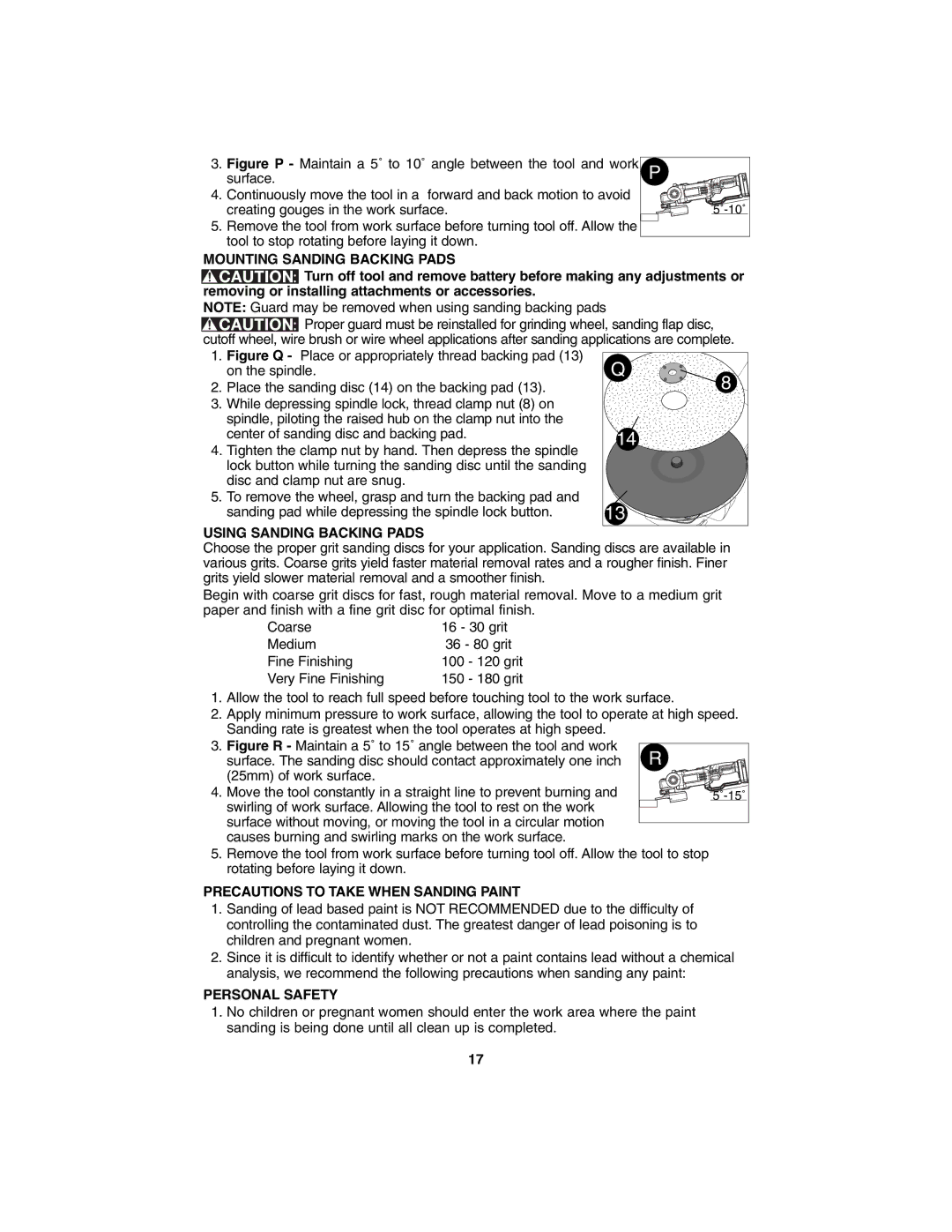
3.Figure P - Maintain a 5˚ to 10˚ angle between the tool and work surface.
4.Continuously move the tool in a forward and back motion to avoid creating gouges in the work surface.
5.Remove the tool from work surface before turning tool off. Allow the tool to stop rotating before laying it down.
P |
MOUNTING SANDING BACKING PADS
![]()
![]()
![]()
![]()
![]()
![]()
![]()
![]() : Turn off tool and remove battery before making any adjustments or removing or installing attachments or accessories.
: Turn off tool and remove battery before making any adjustments or removing or installing attachments or accessories.
NOTE: Guard may be removed when using sanding backing pads
![]()
![]()
![]()
![]()
![]()
![]()
![]()
![]() : Proper guard must be reinstalled for grinding wheel, sanding flap disc,
: Proper guard must be reinstalled for grinding wheel, sanding flap disc,
cutoff wheel, wire brush or wire wheel applications after sanding applications are complete.
1. | Figure Q - Place or appropriately thread backing pad (13) | Q |
| on the spindle. | |
2. | Place the sanding disc (14) on the backing pad (13). | 8 |
3.While depressing spindle lock, thread clamp nut (8) on spindle, piloting the raised hub on the clamp nut into the
| center of sanding disc and backing pad. |
| 14 |
|
|
|
|
|
|
|
| ||
4. | Tighten the clamp nut by hand. Then depress the spindle |
|
|
|
|
|
|
|
|
|
| ||
|
|
|
|
| ||
|
|
|
|
| ||
| lock button while turning the sanding disc until the sanding |
|
|
|
|
|
| disc and clamp nut are snug. |
|
|
|
|
|
5. | To remove the wheel, grasp and turn the backing pad and | 13 |
|
|
| |
| sanding pad while depressing the spindle lock button. |
|
|
| ||
USING SANDING BACKING PADS
Choose the proper grit sanding discs for your application. Sanding discs are available in various grits. Coarse grits yield faster material removal rates and a rougher finish. Finer grits yield slower material removal and a smoother finish.
Begin with coarse grit discs for fast, rough material removal. Move to a medium grit paper and finish with a fine grit disc for optimal finish.
Coarse | 16 - 30 grit |
Medium | 36 - 80 grit |
Fine Finishing | 100 - 120 grit |
Very Fine Finishing | 150 - 180 grit |
1.Allow the tool to reach full speed before touching tool to the work surface.
2.Apply minimum pressure to work surface, allowing the tool to operate at high speed. Sanding rate is greatest when the tool operates at high speed.
3.Figure R - Maintain a 5˚ to 15˚ angle between the tool and work
surface. The sanding disc should contact approximately one inch | R |
(25mm) of work surface. |
|
4. Move the tool constantly in a straight line to prevent burning and | |
swirling of work surface. Allowing the tool to rest on the work |
|
surface without moving, or moving the tool in a circular motion |
|
causes burning and swirling marks on the work surface. |
|
5.Remove the tool from work surface before turning tool off. Allow the tool to stop rotating before laying it down.
PRECAUTIONS TO TAKE WHEN SANDING PAINT
1.Sanding of lead based paint is NOT RECOMMENDED due to the difficulty of controlling the contaminated dust. The greatest danger of lead poisoning is to children and pregnant women.
2.Since it is difficult to identify whether or not a paint contains lead without a chemical analysis, we recommend the following precautions when sanding any paint:
PERSONAL SAFETY
1.No children or pregnant women should enter the work area where the paint sanding is being done until all clean up is completed.
17
